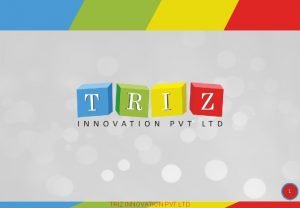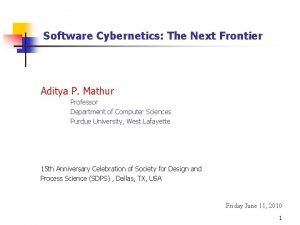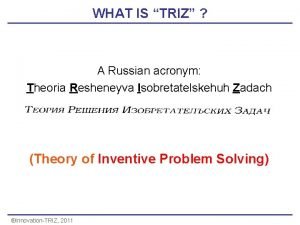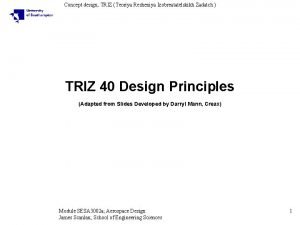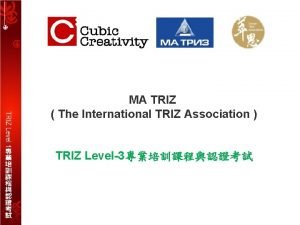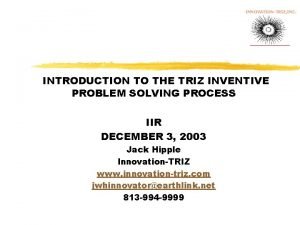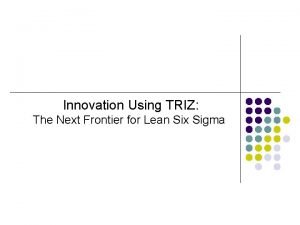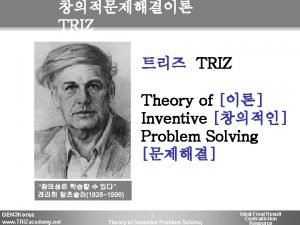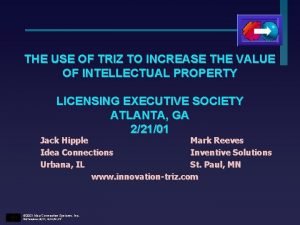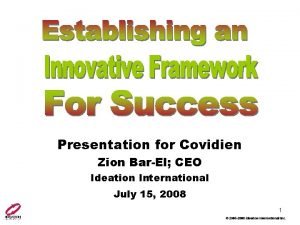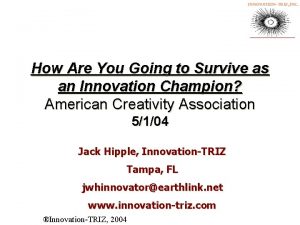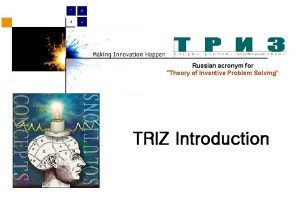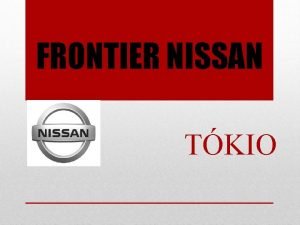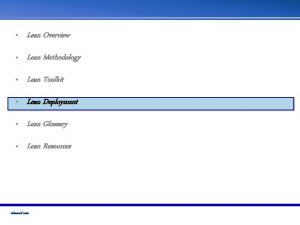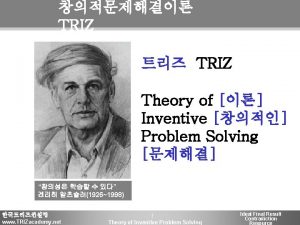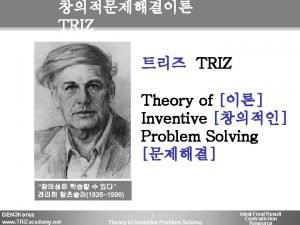Innovation Using TRIZ The Next Frontier for Lean































- Slides: 31

Innovation Using TRIZ: The Next Frontier for Lean Six Sigma

TRIZ (Teoriya Resheniya Izobreatatelskikh Zadatch) (Pronounced ‘trees’ with a roll on the ‘r’) Theory of Inventive Problem Solving

LSS and TRIZ l l l Innovation is “HOT” Rise of the Corporate Innovation Officer; other new career opportunities Clearly, improvement and innovation methodologies are becoming a significant source of competitive advantage! Patents and continuous improvements are becoming blurred. What is “obvious” or “ordinary” or “incremental” or a “simple combination of preexisting inventions? TRIZ and LSS - a perfect complement - the next evolutionary step, incorporating proven innovation methodologies and tools with continuous improvement methods and tools. Group exercise – Please react whenever you see something in this presentation that you can begin to use today with LSS

House of Quality: A Popular Six Sigma Tool The “Roof” Describes Contradictions! Correlation Positive Competitive evaluation X = major competitor 3 4 XA A A 4. 5 4. 4 1. 1 4. 9 20. 7 XA 3. 8 4. 0 1. 6 6. 1 24. 8 X A A 2. 5 4. 2 1. 0 2. 5 10. 2 Briefness 5 4 3 2 1 Target Values X A A 3. 2 Difficulty (qualitative 1 -5) 5 A X A A A A XA X X 4. 0 3. 5 4. 8 4. 5 4. 9 4 4 3 2 3 Absolute Weight 15. 9 92. 5 66. 9 46. 2 18. 2 32. 6 Relative Weight how’s 9. 2 101. 3 84. 9 67 55. 4 34. 9 Relationships Strong =9 Moderate =3 Weak =1 5 8 % Importance Abs Weight XA A A Clarity X A 3. 2 3. 4 1. 0 3. 2 13. 1 5. 0 4. 6 1. 5 7. 5 31. 2 Abs Weight = Ratio*Importance Easy of use Accuracy Technical evaluation (5 is best) 5 Ratio = Target Value/ Company Now 2 Target Value (qualitative) 1 Relevance 4 2 A = Us Importance to Customer Table of Contents Choice of Language Amount of Coverage Use of Graphics Timing of Renewals 1 Customer Requirements Strong Positive Negative Formatting Style 3 Technical Requirements 6 7

TRIZ History • Began as the work of Genrich Altshuller, a patent officer in the Russian Navy in 1946 • Based on a review of 2. 5 million patents to date (200, 000 by Altshuller!) • Aim is to provide a systematic and rigorous way to be more inventive in our problem solving • Focus is on resolution of inherent design contradictions by removing them at their source, rather than compromise • Allows people to study the ideas and the ways that contradictions were solved (“creates the ability to almost automate the inventive process!”)

TRIZ History (continued) • Now a well-developed collection of principles, tools and techniques, including the “ 40 Inventive Principles (IPs)” and the “Contradiction Matrix” • Initially about technical and physical problems, TRIZ ideas and tools are now being applied to business/services! • Now being combined with Lean Six Sigma - a natural, especially with DMADV/DFSS to create Six Sigma capable processes to start • Has its own methodology (ARIZ), but can also be adapted to DMAIC/DMADV “What Six Sigma lacks in the area of systematic innovation TRIZ encapsulates in almost every tool and technique. ” (Geoff Tennant)

Genrich Altshuller: The Father of TRIZ “In his first book, How to Learn to Invent, [Altshuller] laughs at the popular opinion that one must be born to be an inventor. He criticizes the trial and error method used to make discoveries. ” (Lev Shulyak) “You can wait a hundred years for enlightenment, or you can solve the problem in 15 minutes with relative ease. ” (Genrich Altshuller) So you want to innovate. Would you rather start with a blank sheet of paper, use trial and error, do benchmarking, or have a searchable database of millions of patents, and how their solutions led to innovations?

The TRIZ Methodology l l l Study patterns and stages of innovation. Identify current position to determine future direction and potential. Approach innovation at the systems level to consider all aspects of the environment; consider functionality and hidden resources Use an algorithm for problem-solving (ARIZ, DMAIC, DMADV) Solve contradictions; do not compromise Create the ideal system – maximum benefit at zero cost and zero harm Use idle resources (air, knowledge, skills); add (at zero cost) to increase functionality Use the 40 Inventive Principles (IPs) and Contradiction Matrix (grid of most popular IPs for specific parameter conflicts) Separate the contradictions Add a third factor Use science and knowledge for answers Remove the unnecessary/Ask Why?

The 40 Inventive Principles (IPs) 1. 2. 3. 4. 5. 6. 7. 8. 9. 10. 11. 12. 13. 14. 15. 16. 17. 18. 19. 20. 21. 22. 23. Segment* Separate/Extract* Localized Characteristics/ Quality Asymmetry Merge/Consolidate Multi-Functionality/ Universality Nesting Principle Counterweight Prior Counteraction Prior Action* Beforehand Compensation/ Preparation Equi-Potentiality Other Way Around/ Reverse Curvature Increase/ Spheroidality Dynamic Parts* Partial or Excessive Action Change or Move to a New Dimension Mechanical Vibration Periodic Action Continuity of Useful Action Hurrying/Rush Through or Skipping Over Blessing in Disguise/ Convert Harm into Benefit Feedback 24. 25. 26. 27. 28. 29. 30. 31. 32. 33. 34. 35. 36. 37. 38. 39. 40. Intermediary/Mediator Self Service Copying Inexpensive and Short-Term (Instead of Expensive and Durable); Cheap Disposables Interaction Substitute; Replacement of a Mechanical System* Pneumatics and Hydraulics Flexible Shells and Thin Membranes or Film Porous Material Optical Property Change/Changing Color Homogeneity Discarding and Recovering/Rejected and Regenerating Parts Parameter Change/Transformation of the Physical-Chemical Properties of the System or Parts* Phase Transition Application of Heat Expansion (Thermal Expansion) Using Strong Oxidants 39. Inert Atmosphere/ Environment Composite Materials *Most commonly used principles (J. Zhang)

TRIZ: An Illustration of Inventive Principles It’s Not Just for Manufacturing! IP 14: Curvature Increase (Spheroidality) Curvature can be increased by moving from lines to curves, from linear to circular motion, and in one, two, or three dimensions. Use rotational motion and forces rather than linear. E. g. , Ball bearings in toys, coil springs in mattresses, circular tables, domed roofs, knuckle joints as hinges for windows, corkscrew cucumber slicer, non-linear organizational structures, 360 degree feedback, people with “rounded personalities” performing customer service, rolling forecasts of customer requirements, ergonomic furniture, meals on wheels, quality circles, circular work cells, using 3 D virtual models, using educational globes rather than maps for instruction, using smoothing techniques forecasting of data, encouraging out-of-thebox versus linear thinking Can you think of other applications?

Example IP: Periodic Action (IP 19) l Replace a continuous action with a periodic one (impulse) l l If the action is already periodic, change its frequency l l Use impulse sprinkler on lawn to reduce damage to soil Periodic repetition of advertising messages Periodic evaluation/auditing of processes Batch manufacturing – small customized products Mass customization – individual production Institute monthly customer communications, in addition to annual surveys Use pauses between impulses to provide additional action l l Preventative maintenance of equipment and facilities Plan pauses in negotiations Get work done between meetings Capture lessons learned for knowledge management

Example IP: Continuity of Useful Action (IP 20) l Carry on work continuously; make all persons/systems work at full capacity all the time l l l Continuous compounding of interest Provide 24 hour, 7 day service to customers Use retired employees during peak work times, absences, and vacations Bring the services for special education students to the regular classroom, rather that having students go elsewhere for services Remove idle and intermediate motion l l Use mobile phones Create life-long learning opportunities Conduct training during pauses in work Employ multi-skilled personnel at bottleneck functions to avoid customer delays

Mini-Case: Techo Edge Canteen Techno Edge is a university canteen open from 8: 30 am to 6: 30 pm on weekdays, and from 8: 30 am to 2: 00 pm on Saturdays. Since it is not convenient to purchase food elsewhere outside of the operation hours of the canteen, students have requested an extension of hours of operation. The solution, however, may not be welcomed by the food operators for reasons of cost ineffectiveness. Contradiction: Longer hours to meet student demand vs. cost-effective staffing

Mini-Case: Techo Edge Canteen A Solution Using TRIZ Inventive Principles IP 1: Separation in space: Use outside contractors to provide phone ordering/direct delivery. IP 1: Separation within a whole and its parts: Separate the dining needs of customers into types and patterns – provide niche services, such as late delivery. IP 1: Separation in time: Divide the operation into two parts. Use a different operator to provide night-time services. IP 25: Self-Service and IP 10: Preliminary Action: Provide food vending machines and microwave ovens to relieve peak hour demand late night customers.

Key TRIZ Concept: Ideality/Ideal Design l l l Provides all required functions without the physical existence of any system Uses “free” resources (such as gravity, air, knowledge, the effects of shape memory, etc. ) The measure is the sum of the benefits divided by the sum of the “costs” and “harms” Benefits are any useful functions or desired outcomes Costs should include direct costs and costs to society (Taguchi) Harms should include failure modes, harmful effects, and any other undesired outcome

Understanding the Problem: Define the Ideal Outcome l l l l l TRIZ tool is called “The Ideal Final Result” Use Brainstorming, including “Solution Park” Do NOT think about “HOW” we get what we want! Concentrate on BENEFITS! Imagine we have a “MAGIC WAND” Ask everyone in the room to define their ideal outcome and create consensus Define who we are and at what systems level we are operating Decide what we want – the benefits/future state Visualize the solution (future state map, 9 Windows, etc. ) Search for resources to deliver the benefits Identify contradictions for further improvement

TRIZ Tool: Nine Windows (or Screens) Past Present Future Macro System Micro System Used to identify the ideal state, resources that can be used, and understand where the “real” problem/opportunity lies.

TRIZ Tool: Nine Windows Bradford University Example Past Present Future Macro System Micro System Low status and salaries of engineers in UK; Mfg base in decline Loyal, qualified staff; good facilities; demand for graduates by local companies What will the government want? What will the University want? Engineering is less understood and not a popular choice; Qualifications are harder; Business more popular; Male dominated Problem: How to attract many capable engineering students to Bradford? What We Want: Full quota of good students graduating in engineering form Bradford More girls at university; Engineering seek as “geeky” How to insure a good pool of able students? How to inspire enthusiasm for engineering? Students gain employment from local companies

Triz Tool: Nine Windows • Combined with SWOT Analysis Past Macro System Micro System Present Future S W S W S W O T O T O T S W S W O T O T

Triz Tool: The Contradiction Matrix l l The contradiction (in design features) is at the heart of TRIZ. The CM Matrix is a starting point for solution generation, once two features have been found that are currently in a trade-off situation. Two types of contradictions are considered: l l l Technical (i. e. , as one gets better, the other must get worse, such as strong and light weight), and Physical (i. e. , when one parameter must be in two opposing states at the same time, such as big vs. small, short vs. long, etc. ). Only 1250 typical system contradictions in 39 design parameters have been found to date The purpose of TRIZ is to eliminate the trade-off and allow both features to exist without contradiction. Without innovation, designers typically compromise by trading off the two extremes. The method focuses on identifying a single measure (of a feature), and exaggerating the two extremes. The CM Matrix is now a 39 X 39 Matrix with 39 Design Parameters on each side. Each entry contains from 1 -4 of the Inventive Principles (IPs) that should be considered.

Triz Tool: The Contradiction Matrix (partial table) Characteristics (39) Worsening Feature → Improving Feature ↓ 1 1: Weight of a Mobile Object 2: Weight of a stationary Object 3: Length of a Mobile Object 4: Length of a Stationary Object 5: Area of a Mobile Object 6: Area of a Stationary Object 7: Volume of a Mobile Object 8: Volume of a Stationary Object 9: Speed 2 - - 8, 15, 29, 34 - - 35, 28 40, 29 3 4 5 6 8, 15, 29, 34 - 29, 17, 38, 34 - - 10, 1, 29, 35 - 35, 30, 13, 2 - 15, 17, 4 - - 17, 7, 10, 40 - 2, 17, 29, 4 - 14, 15 18, 4 - - 30, 2, 14, 18 - 26, 7, 9, 39 2, 26, 29, 40 - 1, 7, 4, 35 - - 35, 10 19, 14 2, 28, 13, 38 - 13, 14, 8 - Inventive Principles (40) 1: Segmentation 2: Extraction 3: Local Quality 4: Asymmetry 5: Consolidation 6: Universality 1, 7, 4, 17 - 35, 8, 2, 14 - - - 29, 30, 34 - 7: Nesting 8: Counterweight 9: Prior Counteraction

Separation Principles l The Principles: l l l Separation of Parts and Whole: Can the actions/parts/ systems be broken up into smaller parts, or combined into one whole? Separation in Time: Can actions/parts/system be separated in time, or happen before or after the other? Separation in Space: Can the conflict be resolved by physically moving the actions/parts/systems? Can removing a separation in space combine actions/parts/systems to remove the conflict? Separation on Condition: Can the actions/parts/systems be treated/handled differently based on internal or external conditions? Use when one attribute is in contradiction with itself (diagonal of contradiction matrix).

Triz Tool: The Contradiction Matrix (*Use Separation Principles) Characteristics (39) 1 2 3 4 * - 8, 15, 29, 34 - - * - 8, 15, 29, 34 - * - 35, 28 40, 29 - 5 6 7 8 29, 17, 38, 34 - 29, 2, 40, 28 - 10, 1, 29, 35 - 35, 30, 13, 2 - 5, 35, 14, 2 - 15, 17, 4 - 7, 17, 4, 35 - * - 17, 7, 10, 40 - 35, 8, 2, 14 * - Worsening Factor → Improving Factor ↓ 1: Weight of a Mobile Object 2: Weight of a stationary Object 3: Length of a Mobile Object 4: Length of a Stationary Object 5: Area of a Mobile Object 6: Area of a Stationary Object 7: Volume of a Mobile Object 8: Volume of a Stationary Object 2, 17, 29, 4 - 14, 15 18, 4 - - 30, 2, 14, 18 - 26, 7, 9, 39 2, 26, 29, 40 - 1, 7, 4, 35 - - 35, 10 19, 14 35, 8, 2, 14 - * 7, 14, 17, 4 - - 1, 7, 4, 17 - * - - - Inventive Principles (40) 1: Segmentation 2: Extraction 3: Local Quality 4: Asymmetry 5: Consolidation 6: Universality 7: Nesting 8: Counterweight *

Common Service Contradictions l l l Diversity versus Focus Customization versus Standardization Functionality versus Ease of Use General Information versus Detailed Information Security/Privacy versus Transparency Industrialization versus Personalization

Class Exercise: Icebreaker It is necessary to move cargo in the winter through waterways that can be covered by as much as 10 feet of ice. Traditionally, ice breakers have been used to open a channel through the ice for a convoy of ships to follow. The ice breaker can only advance at a speed of 2 km/hr. We need to increase this rate to at least 6 km/hr, although faster would be even more desirable. Alternative means of transportation are not acceptable. Our investigation shows that the icebreaker has the most efficient engine available in the industry at this time. What is the contradiction? Can you think of more than one? (Refer to contradiction matrix list of factors. )

Reverse TRIZ l l l Similar in concept to failure analysis in Six Sigma But can also identify contradictions in the system related to potential failures that are not obvious Asks the question, “If I were going to sabotage the system, how would I do it? The idea is to find the weak spots in the system Once the contradictions are identified, the 40 principles can be used to resolve the failure

TRIZ Tool: Smart Little People (SLP) l l l Using “Smart Little People” helps to overcome the psychological inertia in our thinking. Imagine an army of smart but very small people that can do anything, think for themselves, and work down to the atomic level. Then imagine how they could do a job differently.

Summary - LSS and TRIZ l l l Innovation is “HOT” New career opportunities Clearly, improvement and innovation methodologies are becoming a significant source of competitive advantage! Patents and continuous improvements are becoming blurred. What is “obvious” or “ordinary” or “incremental” or a “simple combination of preexisting inventions? TRIZ and LSS - a perfect complement - the next evolutionary step, incorporating proven innovation methodologies and tools with continuous improvement methods and tools.

The Power of TRIZ According to Michael Orloff: “The methods of TRIZ allow you to find valuable solutions more quickly and with less effort. TRIZ is simply irreplaceable for solutions to very difficult problems. ”* Inventive Thinking through TRIZ, 2011

LSS and TRIZ – A Natural!! TRIZ can be used with Lean Six Sigma to: l Extend the House of Quality – resolve contradictions l “Bust” process bottlenecks - reduce cycle time l Capture knowledge - using TRIZ IPs and characteristics l Expand the toolbox - add TRIZ tools to LSS l Many other possibilities!

Group Exercise: Nine Windows Past Present Macro System Micro System Chewable plant fibres; bamboo handle added; bristles replace fibres Current use of a plastic manual/ electric toothbrush to remove deposits from teeth. Future
 Triz innovation pvt ltd
Triz innovation pvt ltd X.next = x.next.next
X.next = x.next.next Frontier detectors for frontier physics
Frontier detectors for frontier physics Artificial intelligence the next digital frontier
Artificial intelligence the next digital frontier Be next frontier software development
Be next frontier software development Lean innovation educators summit
Lean innovation educators summit Lean innovation network
Lean innovation network Besigheidsplan
Besigheidsplan Disruptive and radical innovation
Disruptive and radical innovation Triz example
Triz example Altshuller institute
Altshuller institute Triz 40 principles
Triz 40 principles Triz level 3
Triz level 3 Triz cereal
Triz cereal Triz matrix example
Triz matrix example Triz theory of inventive problem solving
Triz theory of inventive problem solving Debrifing nima
Debrifing nima Triz template
Triz template Ideation international
Ideation international Triz mbti
Triz mbti Goldfire innovator
Goldfire innovator Kontinuitetshantering
Kontinuitetshantering Typiska novell drag
Typiska novell drag Tack för att ni lyssnade bild
Tack för att ni lyssnade bild Returpilarna
Returpilarna Shingelfrisyren
Shingelfrisyren En lathund för arbete med kontinuitetshantering
En lathund för arbete med kontinuitetshantering Personalliggare bygg undantag
Personalliggare bygg undantag Personlig tidbok fylla i
Personlig tidbok fylla i Anatomi organ reproduksi
Anatomi organ reproduksi Densitet vatten
Densitet vatten Datorkunskap för nybörjare
Datorkunskap för nybörjare
